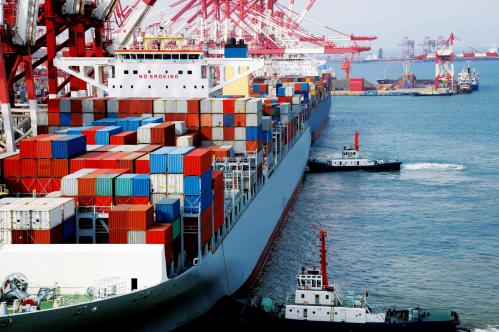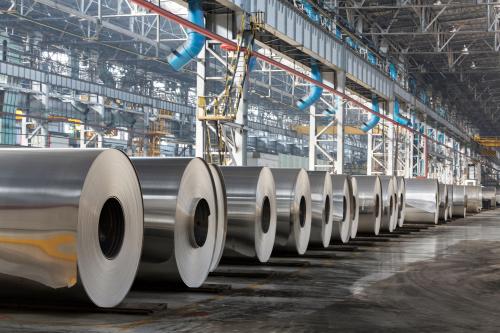This piece was updated on April 20, 2018 to reflect the fact that the 128 products listed for Chinese tariffs in retaliation to American steel and aluminum tariffs went into effect on April 2. The others remain proposed.
The Trump administration’s tit-for-tat with Beijing over potential tariffs has captivated global audiences. Trade experts, diplomats, and news organizations are all fulminating about the high-level performance art being played out by the world’s two largest economies. Gigantic, distant agendas are taking shape.
Yet for all that is remote and portentous about the standoff, China’s lightning-bolt announcements last week with two lists of tariffs on hundreds of American goods—responding to and then precipitating new threats from the Trump administration—had the ancillary effect of bringing the far-away global down to the local.
Trade diplomacy can often seem an international and faraway activity. However, when it comes down to specific lists of tariffs on particular products that Americans produce, from ginseng to airplanes, the high-level posturing of Washington and Beijing suddenly gets more real.
To observe the local effects, therefore, we analyzed the exposure of U.S. industries and places to potential disruption from the two rounds of threatened Chinese tariffs. To do this, we first created a list of the 40 U.S. industries that produce both the 128 products listed by China for tariffs in retaliation to both general U.S. steel and aluminum tariffs, which are now in effect, as well as the 106 products listed for potential retaliation over proposed American tariffs on some 1,300 Chinese goods. We then checked their national and county-by-county employment as a way of gauging industry and local vulnerability to potential trade gyrations. In this fashion, we’ve sketched a granular, bottom-up look at industries’ and locations’ exposure to Chinese saber-rattling, which in turn provides a revealing look at the geography of U.S. production.
What do our tables and maps show? Our top line estimates suggest while the total number of jobs potentially disrupted by an all-out trade war remains modest, the count encompasses a diverse and shrewdly chosen “hit list” of hallmark American industries—one that appears well-calculated to scare both red and blue America.
Altogether, we count some 2.1 million jobs in the 40 industries that produce products now slated for Chinese retaliation, and see a wide variation in the type and number of exposed jobs in those industries. Here’s a look at the industry list:

Scan the list and it ranges from sizable industrial enterprises such as plastics manufacturing, aircraft manufacturing, and automotive/light/truck/motor home production (300,000, 230,000, and 200,000 direct jobs respectively, in 2016); to farm-sector mainstays like corn (18,000 jobs), soybeans (5,000 positions), and hog production and slaughter (147,000 workers); and into specialty industries such as fruit and nut production (187,000 workers), wineries (60,000 workers), and distilleries (12,000 positions).
Overall, the list suggests that Chinese trade bureaucrats have as good, or perhaps even better, of a feel for the diverse and culturally significant key elements that comprise the U.S. production base than their U.S. counterparts. High-tech and low-tech, industrial and agricultural, commodity and specialty production are all represented and put into play.
Map the potentially affected jobs, meanwhile, and it’s very clear that the Chinese have done their homework about the geography of both the U.S. production system and its divided politics.
To confirm this, we mapped the county-by-county location of employment in the 40 potentially affected industries (as a share of the local total); here are the results:

Right off, you can see that the local map of exposure amounts to a bird’s-eye view of how diverse and widely distributed is the American production system.
Immediately the classic heartland manufacturing base jumps out, anchored by auto, SUV, and RV assembly plants in the Midwest and upper South along Interstate 65. Likewise, the familiar Midwestern agricultural complex is visible, with counties dedicated to corn and soybeans, and led by the highly visible rural counties in the Midwest and South that are dominated by slaughter houses.
And yet, the shaded areas of tariff exposure extend way beyond the usual factory and commodity agriculture domain into other realms. Far from the Midwestern factory belt, California is heavily affected, with Napa Valley wines; Central Valley vegetables, fruit, and berry growers; and Los Angeles plastics all potentially impacted. Similarly, rural fruit- and nut-growing counties of the Northwest stand out as exposed as does Snohomish County, Wash., with its 38,000 aircraft manufacturing jobs mostly at Boeing. Also informative is the importance of urban and suburban places, such as Marion County in central Indiana and Montgomery County near Philadelphia, that are involved in the sizable pharmaceutical manufacturing industry.
Indeed, a look at a new map focused on concentrations of potentially affected employment underscores the urban and Far Western cast of worker exposure to potential future China gyrations:

Less far flung than the map of local shares, the map of absolute totals especially highlights a mix of big-city metro export hubs that were discussed here as well as the heavy China trade of the Pacific Coast states, anchored by aircraft, pharma, fruit, and vegetables production.
As to what these patterns say about the current trade skirmishing, a few points are relevant. For one thing, as several of us have said before about trade reliance more generally, the map of U.S. tariff exposure makes clear that while any “trade war” may be entered as a matter of abstract geopolitics, its particular battles will ultimately involve local and regional economies and jobs—with potentially unexpected ramifications. As we wrote before, “trade involves millions of workers in hundreds of real and varied places, and often drives crucial local commerce.” The implication: any coming trade wars will not be remote from America’s local communities, which will likely not remain silent about their views of any potential dislocation.
Which brings up the matter of politics. Here, the data and its geography—likely intentional—seem to guarantee that no clean political divide separates tariff-affected counties from others. Instead, the Chinese tariff lists seem designed to ensure that both parties—and virtually all parts of the country—are maximally disturbed by the ongoing saber-rattling. On the one hand, the 2.1 million potentially tariff-affected jobs are almost evenly distributed in counties that President Trump and Hillary Clinton won in the 2016 election. Along those lines we estimate that some 1,062,000 of the exposed jobs (52 percent of them) lie in red counties and 976,000 in blue counties. That means that both red state and blue state members of Congress will be activated by the faceoff.

Yet on the other hand, the Chinese tariff lists seem optimally designed to especially agitate President Trump’s red-state base. After all, of the 2,742 counties with employment in the industries potentially impacted by the current Chinese tariffs, 2,247 (82 percent) of those counties voted for Trump in 2016, while just 439 (18 percent) supported Clinton.

The upshot: Although select blue-state Democrats will be concerned about threats to aerospace jobs in Washington and pharmaceutical manufacturing jobs in New Jersey and Minnesota, red-state Republican senators and representatives, many of whom have long been proponents of freer trade, must almost all be getting nervous.
In any event, the tariff-impacts map suggests Chinese officials have a canny feel for the geography of U.S. trade exposure and are pushing buttons that ensure the U.S. political system mobilizes pushback.
At the same time, the Trump administration’s apparent seriousness about continuing the standoff guarantees maximum uncertainty for the global economy in the coming months.
In the meantime, however, the intimation of the map is simpler: President Trump’s actions on trade are no longer just talk; they could soon have real implications for real jobs in real local economies.
Download the spreadsheet here for state and county-specific absolute tariff-exposed employment and employment shares.
The Brookings Institution is committed to quality, independence, and impact.
We are supported by a diverse array of funders. In line with our values and policies, each Brookings publication represents the sole views of its author(s).







Commentary
How China’s proposed tariffs could affect U.S. workers and industries
April 9, 2018